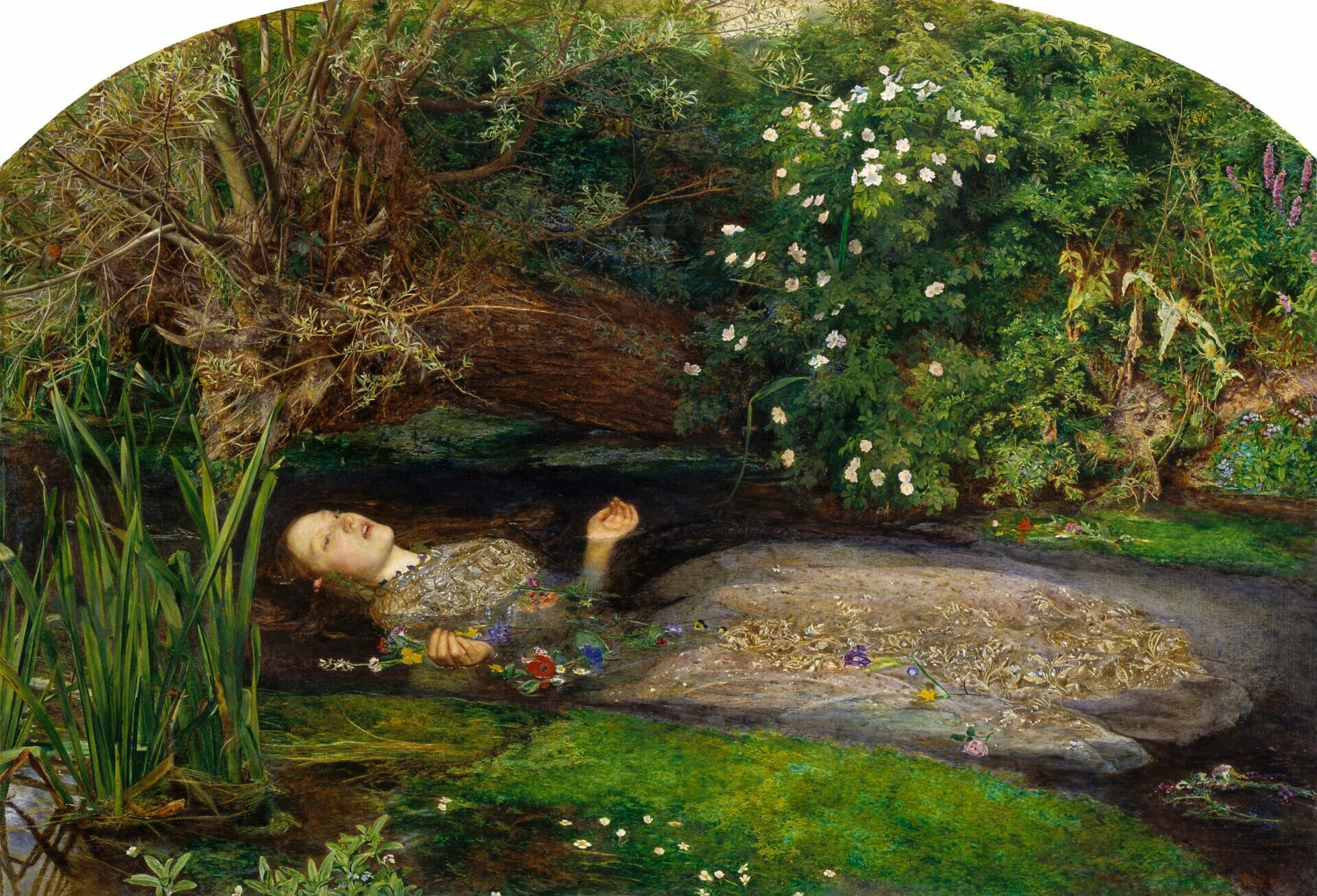
Ophelia | An artistic treaty on Melancholia
Artist
Year
Country
Format
Location of the visited exhibition
Material/Technique
Dimensions
The Pre-Raphaelite artist John Everett Millais painted Ophelia in London between 1851-1852, and it is now on display at the Tate Gallery, London.
The artist painted Ophelia in two different moments. Millais creates the background en plein air, inspired by the vegetation of Ewell (a place where he lived for five months, working on the canvas for eleven hours a day). The artist left a white space in the center incomplete. This to insert Ophelia, impersonated by the model and poet Elizabeth Siddal.

Ophelia, lying in a stream, is covered in flowers.
A tragic story
Elizabeth Siddal, the future wife of Millais’ friend Dante Gabriel Rossetti, was the model who interpreted Ophelia. Millais had the model immersed in the bath of his apartment in Gower Street in London, to reproduce the drowning faithfully and to have the effect of the swelling of the dress immersed in water. This led Elizabeth to fall ill with terrible bronchitis, which permanently affected her health.
Ophelia as a Shakespearean character
The play depicts Ophelia, one of the main characters in Shakespeare’s Hamlet. The girl’s love for Hamlet makes her a victim of this because Ophelia believes that Hamlet does not return her feelings. He will negate his love for her in order not to involve her in Uncle Claudius’ petty affairs. Later, Ophelia becomes insane as Hamlet, the man she loves, kills her father. The girl will then slip into a stream, and so taken by grief and madness, she lets herself drown.
The Pre-Raphaelites
Millais was one of the founders of the Pre-Raphaelite Brotherhood. That was an artistic association related to the current of Symbolism and Art Nouveau. This developed in Great Britain during the Victorian age. The term “Pre-Raphaelites” takes its name from the Renaissance artist Raffaello Sanzio. According to these artists, the Arts before him lived a flourishing and genuine period. After him, Art became polluted and corrupt. In fact, Pre-Raphaelites aimed to abolish the models of Victorian art, taking up the customs and traditions of a nostalgic past. The themes addressed by these artists were: biblical, literary, fairy-tale, historical, and social, with a particular focus on migration and work.
Melancholia, depression, and destruction
Millais’ Ophelia’s death is mentioned, as a true homage to the painter and Shakespeare’s literary work, in the film Melancholia. It’s a film from 201, a drama/fantasy movie, written and directed by Lars von Trier. The film was presented for the Palme D’Or at the 64th Cannes Film Festival. Kirsten Dunst, who portrayed the main character Justine, received the award for best female lead actress. In the film poster, Justine, lying in a stream in her wedding dress, plays the role of Ophelia. Symbol of love, defeated by pain. The film tells the story of two sisters, Justine and Claire. Their relationship is analyzed, as Earth is threatened by the planet Melancholia.
Melancholia is a metaphor for depression, the disease from which Justine suffers. The director has also suffered from the same disease. So this episode has drawn strong inspiration for the creation of the film. The play on words between the name of the planet, Melancholia, and Justine’s pathology, creates parallels between depression and the end of the world. Just as Melancholia is going to crash down upon the Earth and destroy it, so depression is going to destroy the lives of the people who suffer from this pathology, and their families. Because for many families, depression represents the end of the world.
Melancholy, philosophers, planets, and artists
Blood, phlegm, yellow bile, and black bile are the four humors that compose the human psyche, according to Greeks. The excess of black bile could generate melancholia. Aristotle argues in the Problems that “All extraordinary men excellent in philosophy, politics, poetry and the arts are manifestly melancholic”. Marsilio Ficino will resume the thought of Aristotle, in 1489, in his work De vita triplici.
A gift of men born under the planet Saturn was melancholy, but this was not always the case. In the beginning, Mercury was the planet of artists, the planet of the God Hermes, creator of the arts. The change came with the revaluation of Ficino. So, from then on, the “saturnine temperament”, which is dark and reflective, melancholic, became a characteristic of artists.
Melancholy, however, can lead to negative consequences, can produce anxiety attacks and depression. The latter can prove fatal, as in the case of Elizabeth Siddal. The poetess, in addition to health problems caused by bronchitis, suffered from a strong depression, caused by the loss of her son. In the end, the model and the subject of Millais’ painting share the same fate: like Ophelia for the pain of her father’s death, Elizabeth also committed suicide. For Elizabeth too, love, defeated by grief, turned into fatal madness.
Tag






